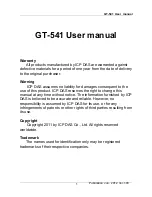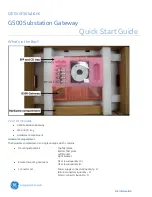
Ubigate iBG3026 Configuration Guide/Ed.00
© SAMSUNG Electronics Co., Ltd.
193
Buffer Requirements Analysis and Buffer Management
Scheme
A more economical scheme can be developed by making a calculated
compromise on the buffer guarantee(availability) for a class. In most cases,
not all classes would simultaneously need to transmit at their BR. Which
means only a few classes, at any given time needs a buffering capacity of bbr
bytes. If all classes are over subscribed and need more than their CR at the
same time, then there is not going to be any unused bandwidth and so each
class can send only bcr bytes in a scheduling interval.(The previous argument
is based on the assumption that the class CRs sum up to the interface
bandwidth). Based on the previous observations, a buffer management scheme
has been devised which is a combination of a ‘shared buffer pool’ and
‘reserved buffer pools’ for each class. This provides each class with a
minimum guarantee of buffers at all times(enough to support the CR) with the
option to borrow additional buffers when needed from a common pool.
This results in more efficient use of buffers by allowing sharing of a portion of
the buffers which the classes don’t always need.
To start off with, we allocate(10 * BCR) bytes of buffering for the entire
interface. This provides a decent amount of burst tolerance of(9 * Ts = 45) ms.
the allocation in terms of buffers would be(10 * BCR / average_packet_size),
where average_packet_size = 100 bytes. Since the sum(bcr) of all classes
makes up the BCR of the interface, each class will have an average of(10 * bcr
/ average_packet_size) buffers.
A class needs at least bcr bytes of buffering to support the CR and bbr bytes to
support BR. We reserve(6 * bcr) bytes or(6 * bcr / average_packet_size)
buffers, so that the class can not only support its CR but also has quite a few
extra buffers that can provide burst tolerance or, support excess bandwidth up
to 6 times the CR. However, we limit the amount of reserved buffers for a
class to(2 * bbr / average_packet_size), because this amount is not only
enough to support the BR but also provides a 100% burst tolerance at Burst
Rate. If a class is configured with a very low CR, it is possible that(6 * bcr
/average_packet_size) results in a very low value, for example, 2 buffers.
To handle this, we always a reserve a minimum of QOS_MIN_RES_
CLASS_Q_SIZE(which is 5 in the current code version) buffers.
The expression below summarizes the above logic for calculating the number
of reserved buffers for a traffic class.
Summary of Contents for Ubigate iBG3026
Page 1: ......
Page 16: ...INTRODUCTION XIV SAMSUNG Electronics Co Ltd This page is intentionally left blank ...
Page 32: ...TABLE OF CONTENTS XXX SAMSUNG Electronics Co Ltd This page is intentionally left blank ...
Page 34: ......
Page 64: ...CHAPTER 4 System Logging 30 SAMSUNG Electronics Co Ltd This page is intentionally left blank ...
Page 72: ......
Page 94: ...CHAPTER 7 WAN Interfaces 58 SAMSUNG Electronics Co Ltd This page is intentionally left blank ...
Page 110: ......
Page 156: ...CHAPTER 15 BGP 118 SAMSUNG Electronics Co Ltd This page is intentionally left blank ...
Page 178: ...CHAPTER 17 VRRP 140 SAMSUNG Electronics Co Ltd This page is intentionally left blank ...
Page 262: ......
Page 288: ...CHAPTER 23 Firewall NAT 248 SAMSUNG Electronics Co Ltd This page is intentionally left blank ...
Page 346: ......
Page 706: ...CHAPTER 36 Management 664 SAMSUNG Electronics Co Ltd This page is intentionally left blank ...
Page 718: ...EQBD 000026 Ed 00 ...
















































